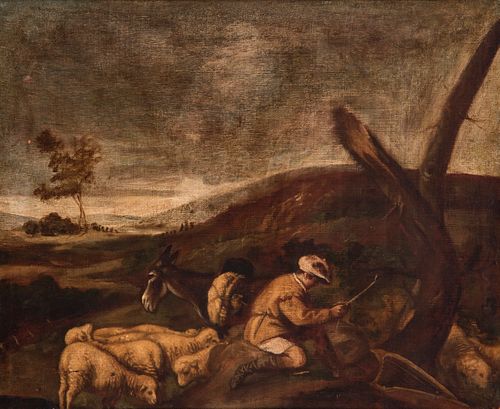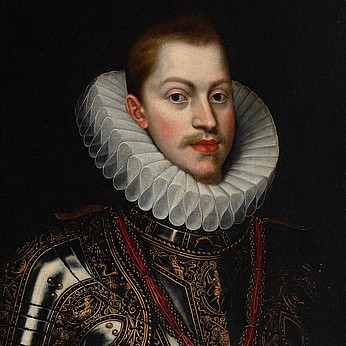Workshop of PEDRO DE ORRENTE (Murcia, 1580 - Valencia, 1645). "Pastoral scene for passage of the Old Testament". Oil on canvas.
Lot 45
About Seller
Setdart Auction House
Carrer Aragó 346
Barcelona
Spain
Setdart Subastas was born in 2004 and is currently the first online art auction in Spain with solidity, prestige and reliability guaranteed by our more than 60,000 users. Setdart has a young, dynamic and enterprising team ready to successfully manage the purchase and sale of art works through custom...Read more
Estimate:
EUR€4,000 - EUR€4,500
$4,166.67 - $4,687.50
Absentee vs Live bid
Two ways to bid:
- Leave a max absentee bid and the platform will bid on your behalf up to your maximum bid during the live auction.
- Bid live during the auction and your bids will be submitted real-time to the auctioneer.
Bid Increments
| Price | Bid Increment |
|---|---|
| EUR€0 | EUR€10 |
| EUR€200 | EUR€25 |
| EUR€500 | EUR€50 |
| EUR€1,000 | EUR€100 |
| EUR€3,000 | EUR€200 |
| EUR€5,000 | EUR€500 |
| EUR€10,000 | EUR€1,000 |
| EUR€20,000 | EUR€2,000 |
| EUR€50,000 | EUR€5,000 |
About Auction
By Setdart Auction House
Nov 24, 2021
Set Reminder
2021-11-24 09:00:00
2021-11-24 09:00:00
America/New_York
Bidsquare
Bidsquare : Old Masters, Day 1
https://www.bidsquare.com/auctions/setdart-auction-house/old-masters-day-1-7873
Setdart Auction House sofia@setdart.com
Setdart Auction House sofia@setdart.com
- Lot Description
Workshop of PEDRO DE ORRENTE (Murcia, 1580 - Valencia, 1645). "Pastoral scene for passage of the Old Testament". Oil on canvas. Relined. Measurements: 57 x 69 cm; 76.5 x 88 cm (frame). During his stay in Venice, Pedro de Orrente must not only have learned the pictorial manners of the Bassano family, but he would also assume their conception of painting as a market-oriented activity. In this sense, the treatment of sacred themes as genre scenes would be fundamental. These were, above all, lively series of biblical stories with which the fans could be flattered by the variety and dynamism of the works, populated by a large number of characters set in landscapes, and accompanied by all kinds of animals and everyday objects. In the present work we seem to recognize David by the harp resting at his side, but he is represented as a shepherd with his sheep. This is a workshop work by the painter Pedro de Orrente. Known as "the Spanish Bassano", Pedro Orrente was an artist of great success in his time, admired as a follower of the formulas of the famous family of artists of Venice, especially in the realization of series of Old Testament themes set in lush landscapes. He lived in several Spanish cities, moving at a very young age from his native Murcia to Toledo, where he was already in 1600. If the fame of the Bassano's works was enormous throughout Spain, the climate in the Castilian city must have been especially receptive to his painting, as evidenced by the works of the best masters who worked there. It is not surprising, therefore, that Orrente, who shortly afterwards would travel to Italy, went to Venice, where we find him as early as 1605. It is quite reasonable to think that he passed through the workshop of Leandro Bassano, whom Jusepe Martínez catalogued as his master. In 1607 he is already back in Spain, installed in Murcia. He continued to visit other Spanish cities, especially Toledo and Valencia, although he must have also spent time in Madrid. During his stay in Venice, he must not only have learned the pictorial manners of the Bassano family, but he would also assume their conception of painting as a market-oriented activity. Contemporary inventories cite a large number of works by Orrente, so we deduce that in order to produce such a large output, the painter must have had a very well-constituted workshop, which repeated the models established by the master. This circumstance also explains the enormous differences in quality that can be found in the catalogued works of this artist. But, although he was already noted in ancient sources for his Bassanesque canvases, Orrente also demonstrated his expertise and versatility in other types of work. Having had first-hand knowledge of the creations of the great Venetian masters, he knew how to adopt the teachings of Titian, Tintoretto and Veronese for his works. In addition, his more than possible passage through Rome would place him in a privileged situation to know in all its apogee the development of the Caravaggist painting and the interest for naturalism, characteristics that he knew how to add to his own works. Works by Pedro Orrente are currently kept in the Prado Museum, the Hermitage of St. Petersburg, the Kunsthistorisches Museum of Vienna, the Metropolitan of New York, the Fine Arts Museums of Bilbao and Valencia and the National Gallery of Denmark, among many others.
- Shipping Info
-
In-house shipping available. Please inquire at admin@setdart.com.
-
- Buyer's Premium



 EUR
EUR CAD
CAD AUD
AUD GBP
GBP MXN
MXN HKD
HKD CNY
CNY MYR
MYR SEK
SEK SGD
SGD CHF
CHF THB
THB
















